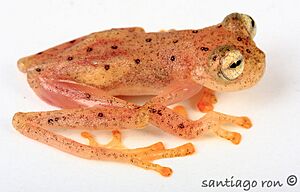Nymphargus anomalus facts for kids
Quick facts for kids Nymphargus anomalus |
|
|---|---|
 |
|
| Conservation status | |
| Scientific classification | |
| Synonyms | |
|
The Nymphargus anomalus is a special kind of frog that lives only in Ecuador. It's found on the eastern side of the Andes mountains, in a place called the Napo Province. People sometimes call it the Napo Cochran frog. It belongs to a frog family known as Centrolenidae.
What Does the Napo Cochran Frog Look Like?
These frogs are quite small. Adult males are about 21 to 25 millimeters long, which is less than an inch. Females are a bit bigger, measuring around 26 to 27 millimeters. This measurement is taken from their snout (nose) to their vent (bottom).
Their snout is short and flat at the end. You can see their tympanum, which is like their eardrum. It's mostly visible, with just a small fold of skin above it.
The frog's fingers have only a little webbing between them and have wide, flat pads at the tips. Their toes are about two-thirds webbed. The pads on their toes are rounder and a bit smaller than the ones on their fingers.
This frog is usually tan in color, which is pretty unusual for frogs in its family. That's why its scientific name, anomala, means "unusual" in Greek! It also has small, black, ring-like spots that have orange-tan centers.
Where Do Napo Cochran Frogs Live?
The Napo Cochran frog lives near mountain streams. You can find them in the plants and trees right next to the water. They live at high elevations, usually between 1,668 and 1,771 meters (about 5,472 to 5,810 feet) above sea level.
These frogs are nocturnal, meaning they are active at night. During the night, male frogs make calls from the plants to attract females. Females lay their eggs on mossy branches that hang over the streams. One male frog was even found on a mossy branch about 1.5 meters (5 feet) above a small waterfall!
Protecting the Napo Cochran Frog
The places where these frogs live have faced some habitat loss, meaning their homes have been damaged or destroyed. For a long time, scientists only knew about one place where these frogs lived.
However, in 2009, good news came! Two new groups of these frogs were discovered. One was found near the Llanganates National Park, and another near the Sumaco volcano. It's not clear if the Sumaco group was inside the Sumaco Napo-Galeras National Park, but finding new populations is a positive step for their protection.


